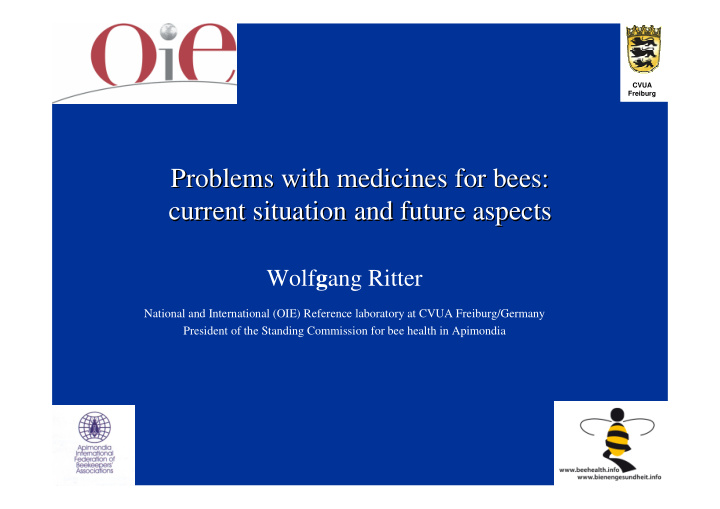



CVUA Freiburg Problems with medicines for bees: Problems with medicines for bees: current situation and future aspects current situation and future aspects Wolf g ang Ritter National and International (OIE) Reference laboratory at CVUA Freiburg/Germany President of the Standing Commission for bee health in Apimondia
Basic prinziples • Beekeepers opinion: „what helps is allowed“ • Safety profile of medicine – Safe use – Acceptable residues – Effectiveness – Low side effects
User`s Risk • Active substance • Application
Residue situation • Application of medicaments leads to contamination of bee nest • Hydrophilic substances – Contaminate honey • Lypophilic substances – Accumulate in wax
Accumulation in Wax • Wax recycling • Comb foundation
Accumulation in Wax Recontamination of honey A. Lipophilic substances (red) transferred to wax Hydrophilic substances (blue) remain in honey B. Lipophylic substance recontaminate honey
Application • Feeding • Food exchange (Trophalaxis) • Food stored – Low risk for applicant – High contamination of food in combs – Effect against bacteria in brood and endoparasites in adults
Application • Trickling • Food exchange (Trophalaxis) – Low risk for applicant – Less contamination of food in combs – Effect against ectoparasite on adults
Application • Permanent strips – Low risk for applicant – Less contamination of food in combs – Effect against ectoparasite on adults and emerging from bee brood (long term)
Application • Vaporization and Evaporation – High risk for applicant – High contamination of food in combs – Effect against ectoparasite on adults and emerging from or in bee brood – Effect against bacterial and fungal brood diseases
Application • Spraying – High risk for applicant – High contamination of food in combs – Effect against ectoparasite on adults (additional grooming) – Effect against bacterial and fungal brood diseases (additional removing)
Application • Dusting – Low risk for applicant – High contamination of food in combs – Effect against ectoparasite on adults (additional grooming) • www.Butterbees.com
Side Effects • Acute toxic effect • Sub lethal doses • Registration: – Short-term and longt-term examinations – Brood tolerance
Side Effects • Disinfectant effect of treatment • Antagonists – Bacteria – Fungi – Antagonistic Substances • Chalkbrood (Ascophaera apis)
Nosemosis • Antibiotics Fumagillin • Nosema apis replaced by Nosema ceranae • Nosema ceranae – Multiply quicker at high temperature – Die off faster at low temperatures • Alternative control methods – Beekeeping management measures – Vegetable active ingredients – Anti-coccidian medicines (off label use)
American Foulbrood • Antibiotics Streptomycin and Tetracycline – Kill vegetative Form of Paenibacillus larvae not spores • America/Asia: Permanent treatment – Re-infection from spores in honey • Europe: Disinfection, killing, shifting – Eradication of spores
European Foulbrood • Antibiotics Oxitetracyclin and other – Kill the vegetative and durable form of Melissococcus pluton • America: occasional treatment • Europe: (no Antibiotics allowed) – Beekeeping management measures (most countries) – Disinfection, Killing, Shifting (some countries like GB, Switzerland)
Small Hive beetle (Aethina tumida) • Coumaphos (Checkmite) • Temperate climate: occasional treatment • Warm climate: permanent treatment • EU regulations: eradication or treatment (epidemiological situation)
Tropilaelaps mite (Tropilaelaps spp.) • Difference to Varroa: – Infest brood only not adults • Varroazids distributed on combs are effective: – Evaporation, Dusting, .. • Varroazids acting via body contact have no or low effect: – Contact (Trickling…)
Varroosis (Varroa destructor) • Treatment in colonies with brood – Long lasting evaporation – Strips present for more than 3 weeks • Treatment in colonies without brood – Spraying – Trickling (only bees in cluster) – Dusting
Varroosis (Varroa destructor) • Resistance with synthetic a.i. – Coumaphos (Italy) – Pyrethroids (Flumetrin, Fluvalinat) (worldwide) – Amtiraz (Portugal) • Uncertain effects with natural a.i. – Climate – Error in treatment
Viruses transferred by Varroa Acute Bee Paralysis Virus (ABPV) Slow Paralysis Virus (SPV) Deformed Wing Virus (DWV) Kashmir Bee Virus (KBV)
Genetic Therapy • Gene silencing (Fire and Mellow) • Principle – Medicament contains double strain RNA (dsRNA) – ds RNA portioned by Enzyme (Dicer) – short interfering RNA (siRNA) – Form silencing complex (RISC) – RISC become specific by srRNA – RISC indentify complementary Virus RNA – Block synthesis of proteins
Virosis (20 Viruses) untreated treated
Prophylactic Vaccination • Basis efficient immune defence system of bees • Force bees to produce body`s own peptides • Bees prepared to kill pathogens and parasites
Conclusions • Flexibility in applying treatment regulations of registered products • Harmonisation of registration • Easier registration of medicines – especially from annex II (EU-reg. • Innovative developments of treatments necessary
Recommend
More recommend